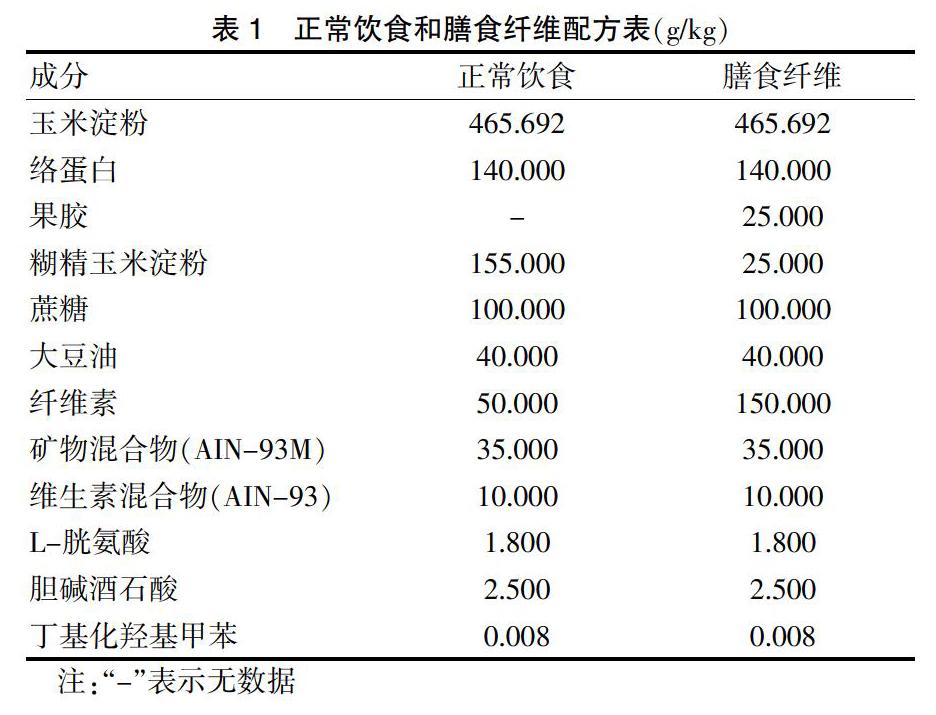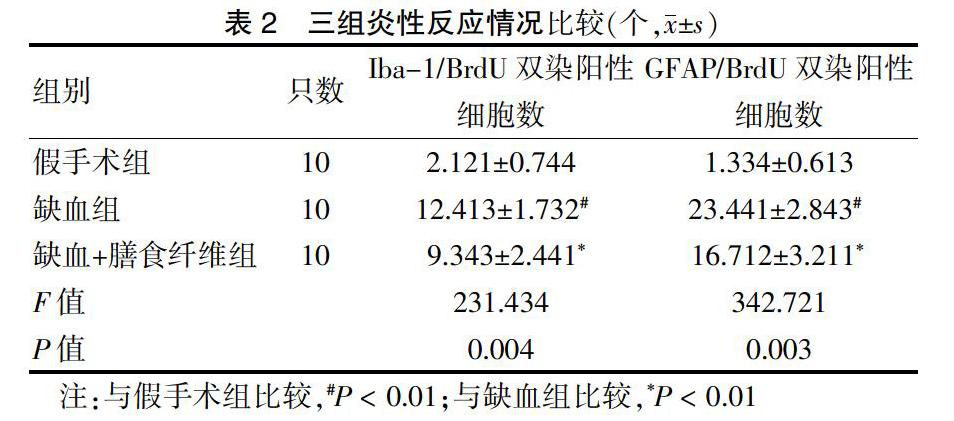添加膳食纤维对大鼠脑缺血后炎性反应的影响
2020-08-27李海涛曲波杨事达
李海涛 曲波 杨事达


[摘要] 目的 探讨添加膳食纤维对大鼠脑缺血后炎性反应的影响。 方法 按照随机分配的原则,将34只成年雄性大鼠分为假手术组(n = 10),缺血组(n = 12),缺血+膳食纤维组(n = 12)。缺血组和缺血+膳食纤维组颅内注射内皮素制作脑缺血模型,有4只大鼠死亡;假手术组颅内注射等体积的生理盐水,所有大鼠均存活;最终假手术组10只、缺血组10只、缺血+膳食纤维组10只。假手术组与缺血组正常饮食,缺血+膳食纤维组添加膳食纤维。测量梗死体积,免疫荧光染色观测各组大鼠梗死周边皮层Iba-1/BrdU与GFAP/BrdU双染阳性细胞数量。 结果 缺血组与缺血+膳食纤维组梗死体积比较,差异无统计学意义(P > 0.05)。缺血组Iba-1/BrdU双染阳性细胞数、GFAP/BrdU双染阳性细胞数多于假手术组,缺血+膳食纤维组Iba-1/BrdU雙染阳性细胞数、GFAP/BrdU双染阳性细胞数少于缺血组,差异均有高度统计学意义(均P < 0.01)。 结论 脑梗死恢复期给予膳食纤维可抑制梗死周边新生的小胶质细胞与星形胶质细胞激活,从而抑制脑梗死后的炎性反应。
[关键词] 脑梗死;膳食纤维;炎性反应;肠道菌群
[中图分类号] R743.31 [文献标识码] A [文章编号] 1673-7210(2020)07(b)-0010-03
[Abstract] Objective To investigate the effect of dietary fiber on inflammatory response after cerebral ischemia in rats. Methods Thirty-four adult male rats were divided into sham group (n = 10), ischemic group (n = 12), ischemic+dietary fiber group (n = 12) according to the principle of random distribution. Endothelin was injected into the brain of the ischemia group and ischemic+dietary fiber group to make the cerebral ischemia model, 4 rats died; while sham operation group was injected with isovolume normal saline, all the rats survived. Finally, 10 rats in sham operation group, 10 rats in ischemia group, and 10 rats in ischemia+dietary fiber group. Normal diet was added to the sham group and ischemia group, dietary fiber was added to the ischemia+dietary fiber group. The infarct volume was measured and the number of Iba-1/BrdU and GFAP/BrdU double staining positive cells in the infarct peripheral cortex of each group was observed by immunofluorescence staining. Results There was no significant difference in infarct volume between ischemia group and ischemia+dietary fiber group (P > 0.05). The number of Iba-1/BrdU double staining positive cells, GFAP/BrdU double staining positive cells in ischemia group were more than those in sham operation group, while the number of Iba-1/BrdU double staining positive cells, GFAP/BrdU double staining positive cells in ischemia+dietary fiber group were less than those in ischemia group, and the differences were all highly statistically significant (all P < 0.05). Conclusion Dietary fiber can inhibit the activation of new microglia and astrocytes around the infarct in the recovery period of cerebral infarction, and thus inhibit the inflammatory response after cerebral infarction.
[Key words] Cerebral infarction; Dietary fiber; Inflammatory response; Gut flora
近年来的研究发现,脑与胃肠道可以通过由中枢神经系统、自主神经系统、下丘脑-垂体-肾上腺轴以及肠神经系统等结构组成的神经-免疫-内分泌网络相互作用[1-3]。此外,有研究[4]显示,肠道菌群与脑血管疾病密切相关。长期的肠道营养可以短暂或永久地改变宿主肠道菌群的稳态[5]。高膳食纤维饮食可以被肠道菌群代谢发酵产生短链脂肪酸,主要包括乙酸、丙酸和丁酸[6]。本研究探讨添加膳食纤维对脑梗死后大鼠脑内炎症细胞的影响,旨在为脑梗死的临床康复提供新的理论基础及治疗靶点。
1 对象与方法
1.1 实验动物
34只成年雄性Wistar大鼠,体重200~250 g,由中国医科大学实验动物中心提供,实验动物合格证号:211002300052024,动物许可证号:SCXK[辽]2015-0001。所有动物实验操作程序符合中国医科大学伦理委员会管理条例要求。动物分组按随机分配的原则,将其随机分为三组:假手术组(n = 10),缺血组(n = 12),缺血+膳食纤维组(n = 12)。
1.2 仪器与试剂
BrdU(生产批号:B3023)、ET-1(生产批号:E6877)均购于美国Sigma-Aldrich公司;Rabbit anti-Iba-1(生产批号:ab178846)、Rabbit anti-glial fibrillary acidic protein(GFAP)(生产批号:ab7260)均购于美国Abcam公司;Alexa fluor 488 goat anti-rabbit IgG(生产批号:A-11034)、Alexa fluor 594 donkey anti-sheep IgG(生产批号:A-11016)均购于美国Invitrogen公司。微量注射器(型号:87943)购于美国 Hamilton 公司;微量注药系统(型号:62000)购于深圳瑞沃德生命科技有限公司;共聚焦显微镜购(型号:Leica TCS SP2)购于德国Leica SP2公司;摇床(型号:6173000)购于德国Heidolph公司。膳食纤维饲料来源于广州市赛柏诺生物科技有限公司。
1.3 方法
1.3.1 颅内注射内皮素(ET-1)制作脑缺血模型 将ET-1用生理盐水稀释成0.500 μg/μL,根据大鼠脑解剖图谱注射到以下3点(AP示以前囟为中心向前,ML示以前囟为中心向侧方,DV示以前囟为中心向下方[7-8]):①AP+0.700 mm,ML+2.200 mm,DV-2.000 mm;②AP+2.300 mm,ML+2.500 mm,DV-2.300 mm;③AP+0.700 mm,ML+3.800 mm,DV-5.800 mm。ET-1用微量注射器以0.500 μL/min注射。注射ET-1后约3 h(此时大鼠麻醉已清醒)若大鼠出现提尾倒悬时右上肢向胸前屈曲或行走时向右侧倾倒或者向右侧转圈,且症状持续超过24 h,可判定为缺血模型制作成功。
缺血组与缺血+膳食纤维组大鼠制作脑缺血模型,有4只大鼠死亡。10只大鼠颅内注射等体积的生理盐水,所有的假手术组大鼠均存活。最终分组为假手术组(n = 10)、缺血组(n = 10)和缺血+膳食纤维组(n = 10)。
1.3.2 膳食纤维的添加 在大鼠大群饲养中,假手术组与缺血组正常饮食,缺血+膳食纤维组在7~35 d添加膳食纤维,经口喂入。大鼠富含膳食纤维的饲料成分配比见表1。
1.3.3 梗死体积的测量 第40天时,使用尼氏染色测量缺血组、缺血+膳食纤维组脑梗死的体积。脑片对侧及同侧半球区域使用NIH Image J 进行测量,每张切片完整半球区域减去梗死半球区域再乘以间隔得到总梗死体积。
1.3.4 免疫荧光染色 免疫荧光染色观测大鼠梗死区域周边GFAP/BrdU及Iba-1/BrdU阳性细胞及GFAP/BrdU、Iba-1/BrdU染色情况:脑片漂洗,血清孵育后,在rabbit anti-Iba-1(1∶500)或GFAP(1∶1000)中4℃孵育过夜,漂洗,在二抗Alexa fluor 488 goat anti-guinea pig IgG或Alexa fluor 488 goat anti-rabbit IgG(1:500)中室温避光孵育2 h,漂洗;然后在2N HCl 37℃水浴箱中孵育45 min,漂洗,血清孵育;随后在抗BrdU抗体(1:500)中4℃孵育过夜,PBS漂洗后,在二抗Alexa fluor 594 donkey anti-sheep IgG(1∶500)中室溫避光孵育2 h,漂洗后贴片、封片。其中Iba-1为小胶质细胞标志物,GFAP为星形胶质细胞标志物,通过Iba-1和GFAP的数量观察膳食纤维对脑缺血后小胶质细胞及星形胶质细胞的影响。
1.4 统计学方法
采用SPSS 16.0统计学软件进行数据分析,计量资料用均数±标准差(x±s)表示,多组间比较采用单因素方差分析,两两比较采用LSD-t检验。以P < 0.05为差异有统计学意义。
2 结果
2.1 缺血组与缺血+膳食纤维组梗死体积比较
缺血组梗死体积为(132.823±10.571)mm3,缺血+膳食纤维组梗死体积为(128.214±11.283)mm3,两组梗死体积比较,差异无统计学意义(P > 0.05)。
2.2 三组炎性反应情况比较
缺血组Iba-1/BrdU双染阳性细胞数、GFAP/BrdU双染阳性细胞数多于假手术组,缺血+膳食纤维组Iba-1/BrdU双染阳性细胞数、GFAP/BrdU双染阳性细胞数少于缺血组,差异均有高度统计学意义(均P < 0.01)。见图1(封四),表2。
3 討论
脑缺血后梗死区域的小胶质细胞及星形胶质细胞会被激活[9],形成的恶性循环促进继发性脑损伤的发生,更加重神经功能的缺失[10]。本研究发现,脑缺血后大鼠梗死区域GFAP与Iba-1细胞明显被激活,与以往研究一致[11]。在大鼠脑缺血后的早期,小胶质细胞及星形胶质细胞就被激活,过早的形成胶质瘢痕[12]。因此,如果能对脑梗死后的炎性反应加以抑制,有可能有效促进神经功能的恢复。
近期有研究[5]显示,长期肠道营养可以短暂或者永久地改变宿主肠道菌群的稳态。膳食纤维可以被肠道菌群代谢发酵而产生短链脂肪酸。短链脂肪酸可以改变肠道菌群的组成[13-15],还可以参与神经胶质细胞的稳态调节,维持中枢神经系统内环境稳定[16-19]。更为重要的是,通过调控中枢神经系统的免疫反应,短链脂肪酸被证实能够减轻多发性硬化动物模型中的神经元轴突损伤[5]。提示应用膳食纤维能够促进神经元的恢复。但其中的确切机制尚不清楚,值得进一步深入探讨。本研究首次探讨添加膳食纤维对大鼠梗死周边炎症的影响。结果显示,脑梗死后应用膳食纤维并不能够减小梗死体积,但能够抑制梗死周边的炎性反应,促进脑梗死后的神经功能修复。
综上所述,本研究推测在脑梗死恢复期给予膳食纤维,可能通过抑制梗死周边新生的小胶质细胞与星形胶质细胞激活,从而抑制脑梗死后的炎性反应。可以更好地了解膳食纤维发挥作用的可能机制并为脑梗死的临床康复提供了新的理论基础及治疗靶点。
[参考文献]
[1] Bercik P,Collins SM,Verdu EF. Microbes and the gut-brain axis [J]. Neurogastroenterol Motil,2012,24(5):405-413.
[2] Cryan JF,O′Mahony SM. The microbiome-gut-brain axis:from bowel to behavior [J]. Neurogastroenterol Motil,2011, 23(3):187-192.
[3] Geschwind DH,Rakic P. Cortical evolution:judge the brain by its cover [J]. Neuron,2013,80(3):633-647.
[4] Karlsson FH,F?覽k F,Nookaew I,et al. Symptomatic atherosclerosis is associated with an altered gut metagenome [J]. Nat Commun,2012,3(4):1245.
[5] Haghikia A,J?觟rg S,Duscha A,et al. Dietary Fatty Acids Directly Impact Central Nervous System Autoimmunity via the Small Intestine [J]. Immunity,2015,43(4):817-829.
[6] Ganapathy V,Thangaraju M,Prasad PD,et al. Transporters and receptors for short-chain fatty acids as the molecular link between colonic bacteria and the host [J]. Curr Opin Pharmacol,2013,13(6):869-874.
[7] Soleman S,Yip P,Leasure JL,et al. Sustained sensorimotor impairments after endothelin-1 induced focal cerebral ischemia (stroke) in aged rats [J]. Exp Neurol,2010, 222(1):13-24.
[8] Biernaskie J,Corbett D. Enriched rehabilitative training promotes improved forelimb motor function and enhanced dendritic growth after focal ischemic injury [J]. J Neurosci,2001,21(14):5272-5280.
[9] Stoll G,Jander S,Schroeter M. Inflammation and glial responses in ischemic brain lesions [J]. Prog Neurobiol,1998, 56(2):149-171.
[10] Ekdahl CT,Claasen JH,Bonde S,et al. Inflammation is detrimental for neurogenesis in adult brain [J]. Proc Natl Acad Sci U S A,2003,100(23):13632-13637.
[11] Takano K,Ogura M,Nakamura Y,et al. Neuronal and glial responses to polyamines in the ischemic brain [J]. Curr Neurovasc Res,2005,2(3):213-223.
[12] Badan I,Buchhold B,Hamm A,et al. Accelerated glial reactivity to stroke in aged rats correlates with reduced functional recovery [J]. J Cereb Blood Flow Metab,2003,23(7):845-854.
[13] Cryan JF,Dinan TG. More than a gut feeling:the microbiota regulates neurodevelopment and behavior [J]. Neuropsychopharmacology,2015,40(1):241-242.
[14] Lu Y,Fan C,Li P,et al. Short Chain Fatty Acids Prevent High-fat-diet-induced Obesity in Mice by Regulating G Protein-coupled Receptors and Gut Microbiota [J]. Sci Rep,2016,6:37589.
[15] Smith PM,Howitt MR,Panikov N,et al. The microbial metabolites,short-chain fatty acids,regulate colonic Treg cell homeostasis [J]. Science,2013,341(6145):569-573.
[16] Braniste V,Al-Asmakh M,Kowal C,et al. The gut microbiota influences blood-brain barrier permeability in mice [J]. Sci Transl Med,2014,6(263):263ra158.
[17] Sharon G,Sampson TR,Geschwind DH,et al. The Central Nervous System and the Gut Microbiome [J]. Cell,2016,167(4):915-932.
[18] Lin HV,Frassetto A,Kowalik EJ Jr,et al. Butyrate and Propionate Protect against Diet-Induced Obesity and Regulate Gut Hormones via Free Fatty Acid Receptor 3-Independent Mechanisms [J]. PLoS One,2012,7(4):e35240.
[19] Wong JM,De Souza R,Kendall CW,et al. Colonic Health:Fermentation and Short Chain Fatty Acids [J]. J Clin Gastroenterol,2006,40(3):235-243.
(收稿日期:2020-01-06)
